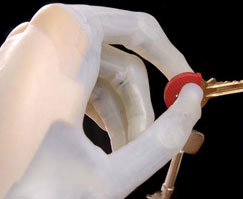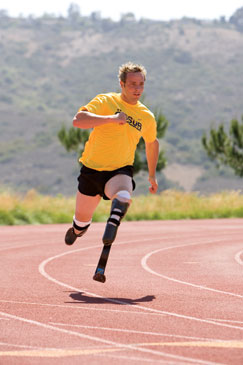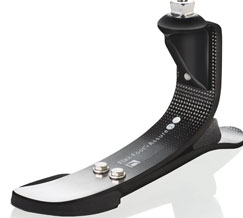Touch and go
In the world of prosthetics a lot can be hidden behind everyday clothing – shoes over feet, trousers over legs – but a prosthetic hand has to leave its user feeling confident.

The i-LIMB Hand is a prosthetic device with five individually powered digits that looks and acts like a real human hand
Touch Bionics of Edinburgh has created the i-LIMB Hand, a prosthetic device with five individually powered digits that looks and acts like a real human hand. Developed using cutting-edge mechanical engineering techniques and manufactured using high-strength plastics, the designers originally approached Paragon Rapid Technologies to develop the mechanical element of the i-LIMB Hand through rapid prototyping.
A further step was taken when looking for materials to produce the i-SKIN, a thin layer of semi-transparent material to accurately wrap to every contour of the hand and move and flex in the same way that human skin does. Paragon was provided with a complete CAD model of the i-LIMB Skin and set about testing various rubbers, eventually arriving at a silicone covering, produced from a stereolithography master pattern CNC machined from Aluminium.
Although available in numerous skin tones, a popular version of the final covering is semi transparent, owing to the love of some patients of the robotic nature of the hand and their desire to wear it without a cosmesis glove. The end result is a futuristic appearance to an already technically life-like bionic human hand.
Breathe easy

Featuring an integrated dose by dose counter 3M’s new inhaler is designed to give users more confidence about when the unit is about to run out
A common companion to most asthma and chronic obstructive pulmonary disease sufferers, the pressurised metered dose inhaler (pMDI) was invented by Riker Laboratories in 1956. That company is now part of 3M, who has taken the design a step further by introducing an integrated dose-by-dose counter.
Until recently patients have had no practical way to tell when their inhaler is about to run out. New legislature now means that all must be fitted with a dose counter. In design terms this means the tricky task of fitting in with the existing valves and canisters in such a compact object.
A full array of CAD tools were employed, including FEA, Moldflow, CFD and tolerance analysis, using Pro/Engineer for the main 3D design. However, it was rapid prototyping that played an enormous part in developing the pMDI. Georgina Fradley, inhalation development specialist at 3M, admits that prototyped samples were essential for enabling feedback from design concepts early in the process, and also from a business perspective. “It enabled us to get concepts into our customers hands at an early stage and gave them confidence that we could achieve all that we had aimed for our design,” she says.
The next step is taking the design to a full commercial scale giving inhaler users more confidence when running low.
Best foot forward
Creating modern prosthetics is a blend of aerospace-grade technology built to encompass human comfort and sensitivity, something Icelandic firm Ossur has become an innovator in.

Oscar Pistorius’ ‘Blades’ are sprint race-ready versions built by Ossur
The designs of Ossur’s Flex Foot are often associated with that of its ‘Cheetah’ variant used famously by Oscar Pistorius in his attempts to compete against able-bodied sprinters in the 2008 Olympics. However, the Flex Foot has more humble beginnings as a prosthetic designed for everyday use.
R&D engineer Christophe Lecomte finds that the use of such materials as carbon fibre, aluminium and titanium lends it better properties than previous hard-foam prosthetics that existed before.
Christophe describes the use of carbon fibre as ideal due to its durable, flexible and strong qualities. “You apply a load and it returns almost like a spring. It’s returning most of the energy, around 90 per cent.”
After initial brainstorming and concept sketches the team of engineers in Ossur’s Icelandic design studio then work in SolidWorks to build a 3D model that can be used in CosmosWorks for testing.
“We calculate the loads and can work the old way with paper and just crunch numbers, however we have a license for CosmosWorks to add on to SolidWorks for testing,” says Christophe.
“We use a lot of aluminium, titanium – aerospace grade materials – we use Cosmos to make calculations about stress points and composite analysis. We can figure how many layers of carbon fibre we need and the loads it can take.”

Ossur’s Flex Foot uses aerospace grade materials and relies on FEA to make calculations about stress points and composite analysis
The benefits of working in 3D also translate into prototyping, as the team uses Materialise to help produce SLA prototypes for covers and moulds both cheaply and quickly.
The process for professional atheletes is different, and although strength testing is used to optimise the limbs for strength and energy return, a lot of the process is simply hands-on to make a one-off product that is tuned as highly as any other essential piece of sports equipment.

Designing medical devices that help transform people’s lives






